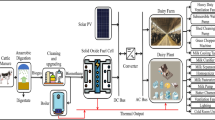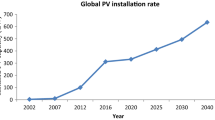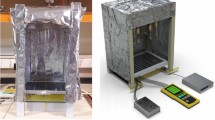Abstract
In this work, the experimental examination was carried out using a mixture of R134a and LPG refrigerant (consisting of R134a and LPG in a proportion of 28:72 by weight) as a replacement for R134a in a vapor compression refrigeration system. Exergy and energy tests were carried out at different evaporator and condenser temperatures with controlled environmental conditions. The results showed that the exergy destruction in the compressor, condenser, evaporator, and a capillary tube of the R134a / LPG refrigeration system was found lower by approximately 11.13–3.41%, 2.24–3.43%, 12.02–13.47% and 1.54–5.61% respectively. The compressor exhibits the highest level of destruction, accompanied by a condenser, an evaporator and a capillary tube in refrigeration systems. The refrigeration capacity, COP and power consumption of the compressor of the R134a /LPG refrigeration system were detected higher and lower compared to the R134a refrigeration system by about 7.04–11.41%, 15.1–17.82%, and 3.83–8.08% respectively. Also, the miscibility of R134a and LPG blend with mineral oil discovered good. The R134a and LPG refrigerant mixture proposed in this study perform superior to R134a from component-wise exergy and energy analyses under similar experimental conditions.



















Similar content being viewed by others
Abbreviations
- e:
-
Specific Exergy, kJ kg−1
- S:
-
Entropy, kJ kg−1 K−1
- E:
-
Exergy Destruction (kW)
- T:
-
Temperature K
- COP:
-
Coefficient of performance
- ODP:
-
Ozone depletion potential
- P:
-
Pressure, Bar
- h:
-
Enthalpy, kJ kg−1
- W:
-
Compressor power kW
- Q:
-
Refrigeration capacity, kW
- MR :
-
Refrigerant charge, g
- d:
-
Diameter of capillary tube, mm
- ΔTsub :
-
Inlet Sub cooling, K
- L:
-
Capillary tube length, m
- D:
-
Coil Diameter, mm
- LPG:
-
Liquefied petroleum gas
- GWP:
-
Global Warming Potential
- ξ:
-
Mass flow rate, kg s−1
- μ:
-
Dynamic viscosity, Pa-s
- evap:
-
Evaporator
- Cap:
-
Capillary
- comp:
-
Compressor
- cond:
-
Condenser
- in:
-
Inlet
- out:
-
Outlet
- el:
-
Electrical
- f:
-
fluid
- h:
-
heater
References
Dincer I, Rosen MA (2005) Thermodynamic aspects of renewables and sustainable development. Renew SustEnerg Rev 9:169–189
Rosen MA, Dincer I, Kanoglu M (2008) Role of exergy in increasing efficiency and sustainability and reducing environmental impact. Energ Policy 36:128–137
Bejan A (2002) Fundamentals of exergy analysis, entropy generation minimization, and the generation of flow architecture. Int J Energy Res 26:545–565
Fang G, Xing L, Yang F, Li H (2005) Exergy analysis of a dual mode refrigeration system for ice storage air conditioning. Int J Archit Sci 6:1–6
Hepbasli A (2007) Thermoeconomic analysis of household refrigerators. Int J Energy Res 31:947–959
Arora A, Kaushik SC (2008) Theoretical analysis of a vapor compression refrigeration system with R502, R404A, and R507A. Int J Refrig 31:998–1005
Ahamed JU, Saidur R, Masjuki HH (2010) Thermodynamic performance analysis of R-600 and R-600a as a refrigerant. Eng E-Trans 5:11–18
Ahamed J, Saidur R, Masjuki H (2011) Prospect of hydrocarbon uses based on exergy analysis in the vapor compression refrigeration system. In: 2011 I.E. 1st Conference on Clean Energy and Technology (CET), IEEE, pp 300–304
Arif EO, Ahmet K, Onder K (2014) Exergy analysis of refrigeration systems using an alternative refrigerant (hfo-1234yf ) to R-134a. Int J Low-Carbon Technol 9:56–62
Saravanakumar R, Selladurai V (2014) Exergy analysis of a domestic refrigerator using eco-friendly R290/R600a refrigerant mixture as an alternative to R134a. J Therm Anal Calorim 115(1):933–940
Mohamed E-M (2015) Energy and exergy analysis of LPG (liquefied petroleum gas) as a drop in replacement for R134a in domestic refrigerators. Energy 86:344–353
Raveendran PS, Sekhar SJ (2017) Exergy analysis of a domestic refrigerator with brazed plate heat exchanger as a condenser. J Therm Anal Calorim 127(3):1–8
Golzari S, Kasabian A, Daviran S, Mahian O, Wongwises S, Sahin AZ (2017) Second law analysis of an automotive air conditioning system using HFO-1234yf, an environmentally friendly refrigerant. Int J Refrig 73:134–143
Gill J, Singh J (2017a) Energetic and exergetic performance analysis of the vapor compression refrigeration system using adaptive neuro-fuzzy inference system approach. Exp Thermal Fluid Sci 88:246–260
Sanchez D, Cabello R, Llopis R, Arauzo I, Catalán-Gil J, Torrella E (2017) Energy performance evaluation of R1234yf, R1234ze (E), R600a, R290 and R152a as low-GWP R134a alternatives. Int J Refrig 74:267–280
IPCC. Climate change (2007) The physical science basis. The working group I contribution to the IPCC fourth assessment report. http://www.ipcc.ch/pdf/assessment-report/ar4/wg1/ar4-wg1-errata.pdf Accessed 4 May 2013
Rasti M, Aghamiri S, Hatamipour MS (2013) Energy efficiency enhancement of a domestic refrigerator using R436A and R600a as alternative refrigerants to R134a. Int J Therm Sci 74:86–94
Sekhar SJ, Lal DM (2005) HFC134a/HC600a/HC290 mixture a retrofit for CFC12 systems. Int J Refrig 28:735–743
Mohanraj M, Muraleedharan C, Jayaraj S (2011) A review of recent developments in new refrigerant mixtures for vapor compression based refrigeration, air conditioning and heat pump units. Int J Energy Res 35(8):647–669
Akash BA, Said SA (2003) Assessment of LPG as a possible alternative to R-12 in a domestic refrigerator. Energy Convers Manag 44:381–388
Ahamed JU, Saidur R, Masjuki HH, Sattar MA (2012) Energy and thermodynamic performance of LPG as an alternative refrigerant to R-134a in a domestic refrigerator. Energy Education Sci Technol Part A-Energy Sci Res 29(1):597–610
Srinivas P, Chandra RP, Kumar MR, Reddy N (2014) Experimental investigation of LPG as refrigerant in a domestic refrigerator. J Mech Eng Res Technology 2(1):470–476
Taiwo Babarinde OS, Ohunakin DS, Adelekan SA, Oyedepo AS (2015) Experimental study of LPG and R134a refrigerants in vapor compression refrigeration. Int J Energy Clean Environ 16(1–4):71–80
Adelekan DS, Ohunakin OS, Babarinde TO, Odunfa MK, Leramo RO, Oyedepo SO, Badejo DC (2017) Experimental performance of LPG refrigerant charges with varied concentration of TiO2 nano-lubricants in a domestic refrigerator. Case Stud Thermal Eng 9:55–61
Yang Z, Liu B, Zhao H (2004) Experimental study of the inert effect of R134a and R227ea on explosion limits of the flammable refrigerants. Exp Thermal Fluid Sci 28:557–563
Sarbu I (2014) A review on substitution strategy of non-ecological refrigerants from vapour compression-based refrigeration, air-conditioning and heat pump systems. Int J Refrig 46:123–141
Avinash P, Jabaraj DB, Lal DM (2005) Beyond for air conditioners – an outlook. IRHACE J 17(1):20–23
Tashtoush B, Tahat M, Shudeifat MA (2002) Experimental study of new refrigerant mixtures to replace R12 in domestic refrigerators. Appl Therm Eng 22:495–506
Gill J, Singh J (2017b) Adaptive neuro-fuzzy inference system approach to predict the mass flow rate of R134a/LPG refrigerant for straight and helical coiled adiabatic capillary tubes in the vapor compression refrigeration system. Int J Refrig 78:166–175
Gill J, Singh J (2017c) Performance analysis of vapor compression refrigeration system using an adaptive neuro-fuzzy inference system. Int J Refrig 82:436–446
Gill J, Singh J (2017d) Experimental analysis of R134a/LPG as replacement of R134a in a vapor-compression refrigeration system. Int J Air-Condition Refrig 25:1750015
ISO, International Standard Organization (1991) International Standard-8187, Household refrigerating appliances (refrigerators/freezers) characteristics and test methods. International Organization for Standardization, Switzerland
Sekhar SJ, Lal DMS (2004) Renganaraynan.Improved energy efficiency for CFC domestic refrigerators retrofitted with ozone friendly HFC134a/HC refrigerant mixture. Int J Thermal Sci 43:307–314
Yataganbaba A, Kilicarslan A, Kurtba I (2015) Exergy analyses of R1234yf and R1234ze as R134areplacements in a two evaporator vapor compression. Int J Refrig 60:26–37
Fatouh M, El Kafafy M (2006) Experimental evaluation of a domestic refrigerator working with LPG. Appl Therm Eng 26:1593–1603
Moffat RJ (1988) Describing the uncertainties in experimental results. Exp Thermal Fluid Sci 1:3–17
Padmanabhan VMV, Palanisamy SK (2013) Exergy analysis of hydrocarbons mixture refrigerants R436A and R436B as a drop in replacement for R134a with TiO2 nanoparticles. Int J Exergy 12(3):405–422
Mohanraj M (2013) Energy performance assessment of R430A as a possible alternative refrigerant to R134a in domestic refrigerators. Energy Sustain Dev 17(5):471–476
Acknowledgements
The authors would like to acknowledge the IKG PTU, Kapurthala and BCET Gurdaspur for their excellent support.
Author information
Authors and Affiliations
Corresponding author
Ethics declarations
Conflict of interest
The authors declare no competing financial interest.
Rights and permissions
About this article
Cite this article
Gill, J., Singh, J. Component-wise exergy and energy analysis of vapor compression refrigeration system using mixture of R134a and LPG as refrigerant. Heat Mass Transfer 54, 1367–1380 (2018). https://doi.org/10.1007/s00231-017-2242-x
Received:
Accepted:
Published:
Issue Date:
DOI: https://doi.org/10.1007/s00231-017-2242-x




